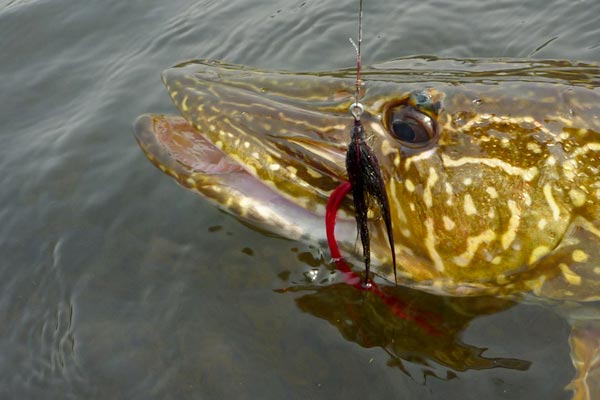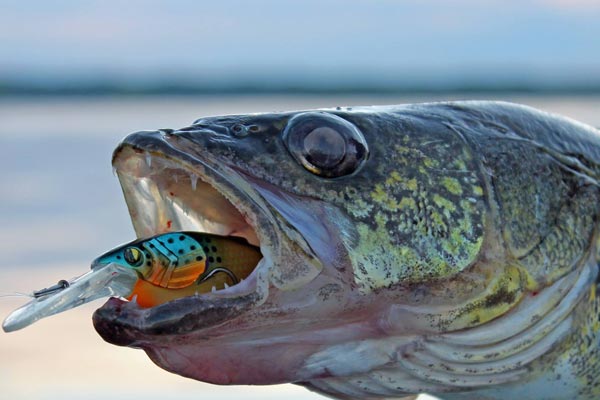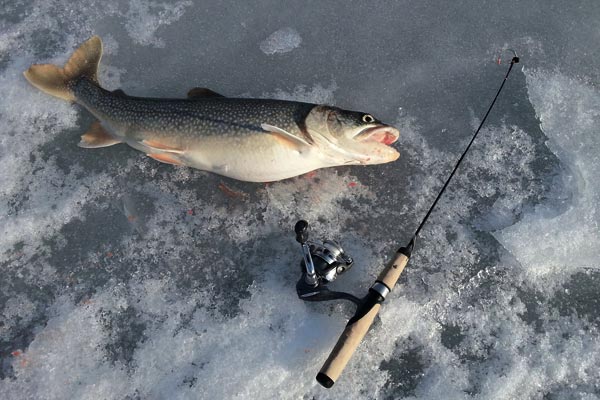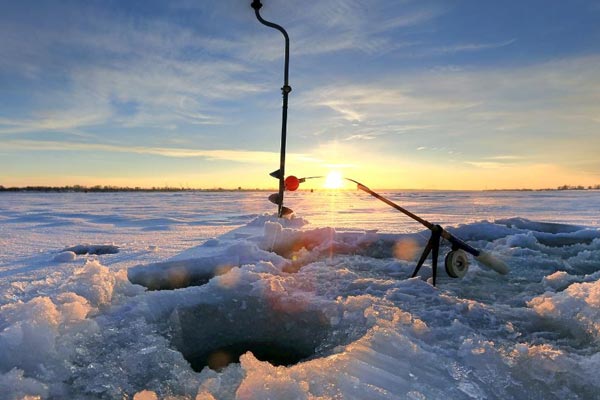The Northern Pike is one of many fishermen’s favorite fish to target during winter.
They’re known for their beautiful scale patterns and aggressive fighting habits, making them fun to catch. They also make an excellent winter dish if you’re skilled with a fillet knife.
Whether you are a skilled veteran or a novice angler, the tips offered in this guide will help you improve your Northern Pike ice fishing skills.
Before getting into the thick of things, here is an excellent vlog demonstrating a successful day using the methods mentioned in this guide.
The video covers what to do if there are problems with a rigging system/technique and offers helpful tips you can use while ice fishing for Northern Pike.
Northern Pike Location and Feeding Habits During The Winter
The Northern Pike is an aggressive predator which prefers to hide in thick vegetation for an ambush strike or stalk its prey at a distance.
According to Drowning Worms, When their prey is within striking range, they use their narrow physique and razor-sharp teeth to explosively shoot toward their prey at speeds of over 10-15 miles per hour.
Since prey locations change throughout the year, the pike’s ambush spots also change.
During the early winter ice formations, they will typically be seen around shallow bars, points, and weed edges, searching for weakened prey.
Most of the bait fish may still be inland so the pike will be too.
After the ice has capped off on the lake surface, surviving prey fish will move on to deeper and warmer water near pockets of vegetation at the lake bottom.
Likewise, the Northern Pike will relocate near their prey while being spread out enough from other predators.
If you are unfamiliar with the lake structure, it can take hours to find the bait fish.
Thanks to modern electronics, you can easily find depth, temperature, fish, and structures along the bottom of the lake.
Here are a couple of products you may like to try out on Amazon:
Check the prices of Marcum RC5P Recon 5 Plus Underwater Camera Viewing System.
Check the Prices of the 7″ Color LCD 600tvl Waterproof Fish Finder Underwater Fishing Video Camera.
How To Present & Rig Lures For Northern Pike
Once you find a solid group of baitfish and vegetation, you may want to spread out your fishing holes for the best chance of landing a pike.
Since Northern Pike don’t attend school together, they tend to survey the lake bottom near baitfish, and sometimes the area can be pretty large.
Jonny Petrowski, a northern Minnesota guide, suggests drilling four holes in a diamond pattern over a baitfish school and putting the fifth hole in the center.
In this method, he will plant a tip-up rig in the center and jig around the outside holes to draw pike into the area.
Tip-up rigs work exceptionally well for winter pike fishing since their flag shoots up when a fish has started pulling your bait away. This allows you to fish multiple holes without monitoring only one hole.
According to Outdoor Canada, At the bottom of each tip up, you may consider tying your hooks using the quick-strike method.
The rig has a treble hook tied at the bottom of a leader, with a second treble hook sliding along the length of the leader.
You would then hook the fixed treble into the head of your bait and hook the sliding treble into the dorsal fin of the bait.
Presenting the bait in this fashion will allow it to sit horizontally in the water, making it appear more natural to the pike.
You may also notice a more effective hook set when the pike decides to run with the bait.
What Should Line & Hook Size Be Used For Northern Pike?
According to the American Expedition, On average, the Northern Pike grows up to 24-30 inches long and 3-7 pounds, although the largest ever caught was 68 pounds and 58 inches long.
Since they can be so aggressive and large, you don’t want to cut your line strength short.
Shoot for no less than a 20lb test line but go with around 50 lb if you want to be on the safe side.
You will need a 6-12 inch wire leader at the end of your rigs near your bait. Northern Pike has a set of razor-sharp teeth and will try to use them to cut your line if they can.
On float rigs, you may prefer to use the 6-inch leader since it will have less impact on the action of your setup.
When choosing a hook, ensure you find a good quality hook that will hold up to their thrashing.
Treble hooks for pike should be #4 or #6 in size. If you are using circle hooks instead of treble hooks, make sure they are around 1/0 to 3/0 in size.
Which Natural Baits Attract Winter Pike?
According to Tourism Northern Ontario, predatory fish like Northern Pike prefer to exert less energy in catching their prey during the cold seasons.
This may be because temperatures are colder and less oxygen is in the water.
Since baitfish can also become weaker from these conditions, pike will naturally feed on them.
According to Excellent Adventures, While naturally feeding, pike will eat just about anything presented to them, whether it be other predatory fish like walleye, perch, bass, or smaller baitfish.
However, while ice fishing, most fishermen have more luck stringing on a baby sucker, chub, or minnow.
You can string them on the dead, but remember that pike may more aggressively strike bait that is somewhat alive since their sensory instincts draw them in with movement and flashes.
If you are fishing using dead bait, try jigging them along the bottom of the lake.
A small baitfish strung onto a quick-strike rig will attempt to struggle and escape, which does most of the work of luring a pike.
You can’t go wrong with a semi-alive bait fish if you want the most natural presentation possible.
What Kind of Artificial Lures Work Well For Winter Pike?
According to Lake-Link, In some cases, a lake may not allow you to use natural bait, or you may have better luck jigging an artificial lure.
Since pike are easily lured with movement and flashes, artificial lures make a fool-proof choice for most anglers.
Many anglers targeting pike with tip-up rigs will also use an artificial jigging lure in other holes while waiting for a strike on their tip-up.
It lures the pike in and gives you more control over the activity level throughout the day.
Northern Pike will typically be seen around drop-off points or the outer edges of schooling baitfish.
They may also scour along the bottom of a weed flat, waiting for a bait fish to wander away from their school.
Try drilling a hole near these sections to get the best type of coverage with a jig.
You can use several different styles of jigs on Northern Pike, like soft plastics on a jig head, rattle baits, hair jigs, or even simply tying a weighted swimbait on the end of your leader.
Since you’ll be drilling down and fishing from a hole, you’ll want a jig bait that can efficiently work within one spot.
As far as color is concerned, you can usually get away with the classic silver/red combination or even a couple of bright-colored chartreuse patterned jigs.
The more flashy contraptions on the jig, the better. If they don’t want to strike a specific profile or color, change it to something more discreet.
The Methods Used By Pros To Catch Winter Pike
As mentioned above, drilling multiple holes and focusing on luring the pike into the hot zone is an effective method many veteran pike fishermen use to catch more pike.
Once you get those pike in the area of your tip-ups, you’ll need to focus on landing them.
Make sure you have your line set at the correct depth. Bait, about 3 inches from the bottom of the lake, will be easiest to see for a pike rather than bait sitting directly on the bottom.
You can usually feel when the bait has hit bottom when the line goes slack in your hand or from your pole. Then it would be best to pull it up a few more inches.
Some anglers like to use underwater cameras as they are jigging in a hole to see where the pike is and when they need to jig their bait.
If you don’t have one of these cameras, you can jig the bait every 30 seconds. Please don’t go too wild with the jigging, or it may not seem natural to the pike.
When you know a pike is close by but isn’t biting, you can try to jig the bait up suddenly or quickly.
This simulates an injured baitfish that has been spooked. The Northern will think that the fish is so injured and weak that it can’t swim away very far, so it may come in and eat it.
After a pike grabs your bait, they will run off with it a little, but don’t let them get too far to where they can tangle the line on vegetation.
The trick here is to find which way they are running with your bait and position yourself on the opposite side of the hole. Pull quickly enough so that the hook sets in the mouth of the pike.
If you feel the tension on the line loosen up, the pike has either not been hooked enough or is swimming toward the hole.
Don’t stop pulling the bait from your tip if you feel slack in the line because they can quickly shake the lure out of their mouth if tension isn’t exerted.
However, Northern Pike can quickly switch directions and snap your line. That’s where you have to pay attention.
If they start pulling hard, let them take your line out a little while but keep sufficient tension simultaneously. Eventually, they will tire out and give in to where you can land them.
How To Target and Catch Monster Winter Pike
While you may get a ton of pike in the vicinity, and your pike catch has been good, you can’t always expect to land a monster.
However, the jigging and attention to the area may draw some in. If you know that pike has been attracted to the area, why haven’t the big ones decided to bite?
Sometimes it all has to do with your bait, particularly the size of your bait. You can catch small pike all day on a small swimbait.
If this pike has enough strength and energy to eat the bait, it will go for it.
However, a large pike may not bother with smaller bait if they feel that the energy used to take them in isn’t worth the effort.
A large pike may have ahead almost a foot long and a mouth that measures up. This means they can fit bigger prey fish into their mouth, like baby walleye or adult perch.
If some of these bigger species are in the area, try fishing some up to use as bait or a large-sized bait fish.
More big pike is likely caught in lakes with healthy perch populations and plenty of vegetation.
Here is a perfect video demonstrating what it’s like target trophy Northern Pike.
The particular lake they are fishing in is known for having trophies, so they target them with baitfish suited to their location.



